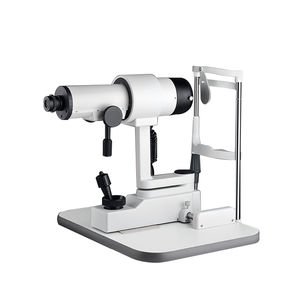
- Secondary care
- Ophthalmology
- Automatic keratometer
- Chengdu SDK Medical Science and Technology

- Products
- Catalogs
- News & Trends
- Exhibitions
Automatic keratometer SW-100hand-held
Add to favorites
Compare this product
Characteristics
- Type of instrument
- automatic keratometer
- Ergonomics
- hand-held
Description
The measurement of the curvature of the anterior surface of the cornea by the keratometer can provide a basis for selecting the appropriate base curve of the soft contact lens. It can also be used to check the corneal astigmatism through the keratometer to provide a reference for optometry.
The keratometer is used to measure the curvature of each meridian on the front surface of the cornea that is about 3mm in the center, that is, the radius of curvature and the curvature, so as to determine whether the cornea has astigmatism, astigmatism, and axial direction.
Product Description
The clinical functions of the keratometer are as follows:
1. During the fitting process of contact lenses, the base curve of the lens can be selected according to the radius of curvature of the principal meridian of the anterior surface of the cornea of the customer.
In selecting the base curve of the lens, the base curve of the lens is equal to or slightly larger than the radius of curvature of the principal meridian of the anterior surface of the cornea. The following formula can be used to obtain:
BC = the sum of the radii of curvature of two mutually perpendicular principal meridians/2×1.1
For example, the curvature radii of two principal meridians that are perpendicular to each other are measured to be 7.6 and 7.8.
BC=7.6+7.8/2×1.1 =8.47
2. Evaluate the tightness of contact lenses after wearing.
When testing, make the wearer blink. If the wearer is well worn, the visual mark will always be clear and unchanged;
If worn too loosely, the image will be clear before blinking, and the image will be blurred immediately after blinking, and it will be clear again after a while;
Other Chengdu SDK Medical Science and Technology products
Optometry Glasses Series
Related Searches
- Ultrasound system
- B/W ultrasound system
- Tabletop laser
- Portable ultrasound system
- Fixed ophthalmic examination
- Tabletop ophthalmic examination instrument
- Ophthalmic biomicroscope
- Hand-held ophthalmic examination instrument
- Table ophthalmic biomicroscope
- Workstation with chair
- Ophthalmoscope
- Ophthalmic workstation
- Ophthalmic laser
- Refractometer ophthalmic examination
- Automatic refractometer
- Keratometer ophthalmic examination
- Automatic optical lens processing system
- Automatic keratometer
- Digital slit lamp
- Retinal camera
*Prices are pre-tax. They exclude delivery charges and customs duties and do not include additional charges for installation or activation options. Prices are indicative only and may vary by country, with changes to the cost of raw materials and exchange rates.











